What should I say — about Seoul 서울에 관하여



What should we say about Seoul? When we started this book we wanted to create an alternative tourist guide to the city. We took photos, talked to local designers, and tasted the Korean cuisine. Back at home, we became painfully aware that our impressions weren’t so alternative after all. We had fallen into the trap of documenting and viewing Seoul through a typical western lens—thereby reproducing a stereotype. This was a humbling discovery about ourselves. So, where to go from here? Ditch the whole project or start anew? We decided to double down on subjectivity. But instead of just portraying our subjective viewpoint, we asked others to include theirs as well. This way, the book gives a glimpse into South Korean society that is not so common after all. By no means is the book all-encompassing. We focused on the works and experiences of designers because that is what we could relate to the most considering we are design students ourselves.
Some of the insights into the Seoul work experience appear grim at places. We think this was in part colored by the ongoing pandemic that forced people to cut down on social
interactions. Despite the work conditions, the designers we spoke to where overall happy with the work they did.
We also included the experiences of Korean-German designers in the book and through that we noticed that there is really no reason to think of Germany as a country that “has it figured out.” The modern workplace can be a very mixed bag at times and bad working conditions plague the creative industry worldwide. Speaking about these experiences allows us to feel less isolated and work towards change—so it is not all doom and gloom. Over all, we encountered many instances of motivation and inspiration in the interviews. The interviews also gifted us with the title for the book. When formulating answers to our questions the interviewees often used the phrase “뭐라고 하지?” (molago haji—“What should I say?”). This grasping for words expressed our own uncertainty over formulating something definitive about Seoul so we found it to be a perfect fit for the book’s title.
So, what should we say about Seoul? Nothing conclusive, but a lot that makes you want to know more.
David Wiesner, Omid Fröhlich, Youjin Kim Editorial Staff




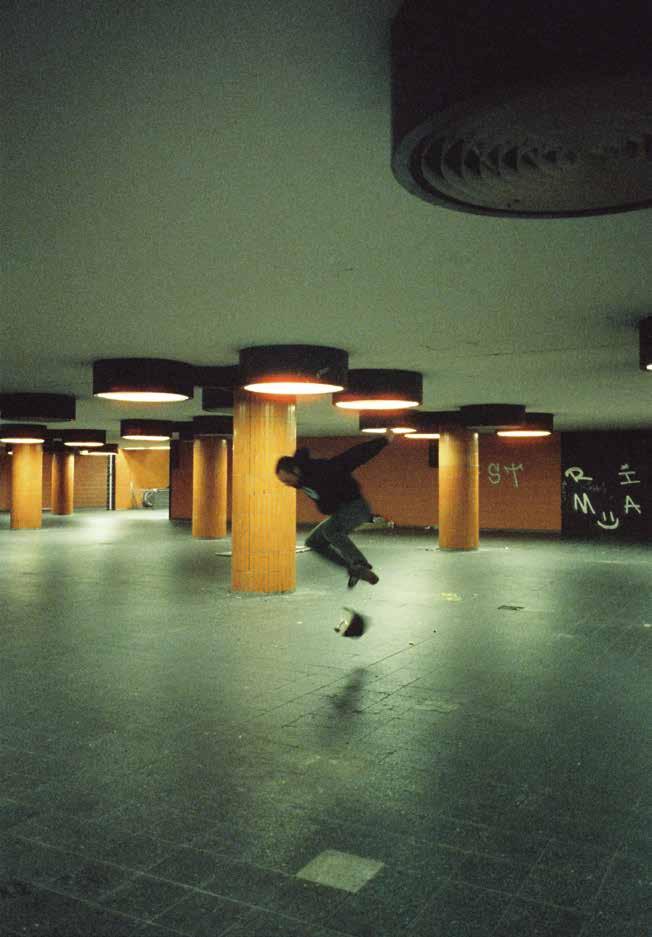


Well, since I studied Design, I had really no other choice than to become a designer. In the beginning it was very difficult. I was always questioning myself and doubting my work. I thought nobody wanted my Design. I am really proud to create the design for this year’s ‘Pride Parade’ in Seoul. Being part of the community myself, it feels great that I can contribute to the parade. The biggest obstacles I face in my design process are grids and typography. This is possibly why I get so much inspiration from my former teacher. Looking at
How did you end up doing what you do?

Should I Say
What work are you especially font of and tell me w hat makes it special to you?
How do you get over obstacles in your design process?
the work of other designers allows me to see my own designs from a new perspective and inspire me to explore new ideas. I like to go out with my boyfriend. We visit new restaurants or just walk around the city together. The whole city is made up of restaurants—you know, because everyone loves good food in Korea. So it’s really nice to discover new restaurants and cafés.
Living with my boyfriend in a small apartment is not easy. I also am worried about politics a lot.

With
millions of commuters daily, the Seoul Metropolitan Subway is one of the busiest metro systems in the world.


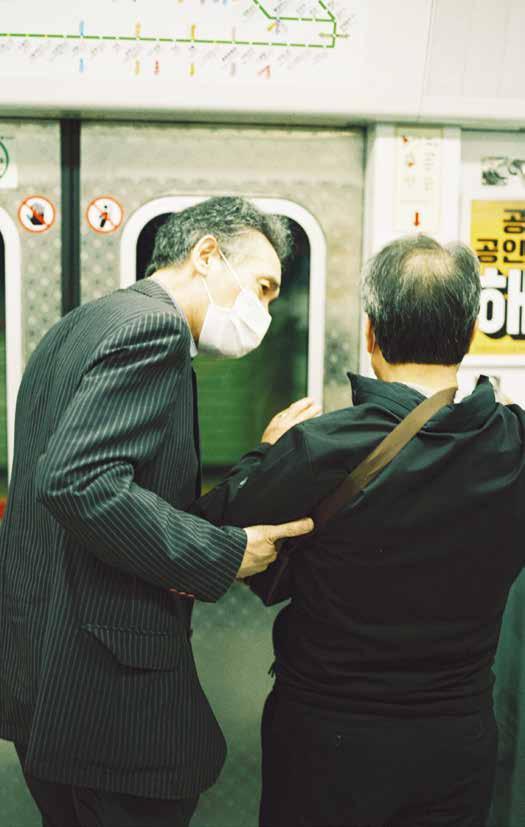
Words & Pictures: Kaon Kim | Maps: openstreetmap.org & map-stylizer by Absolute-Tinkerer
Talking about old age can be frightening. Getting old is often associated with weakness, loneliness, ugliness, and boredom. In most contemporary cultures, staying young both from the look and lifestyle is a big topic of interest. The truth is, no matter what anti-ageing procedures we take, we all eventually become old. In fact, our lifetime as an old person is getting longer. The statistics show that the number of people over 80 years is going to increase more than threefold in the next three decades (UN, 2017). Never before have people lived longer than today thanks to improved living conditions, hygiene, and preventive health care. The world’s institutions of different levels are adapting to this demographic shift in their policies in terms of infrastructure, healthcare system, as well as community building. However, there is less attention paid to the consequences the longer lifespan brings to what it means to be old. How the media is projecting a person in his mid-sixties, for example, has not changed much from the time when we were expected to live only for few years further. Now that we expect to live another 20 years after retirement, we have to search for new models by which to grow old, and challenge stereotypes that there is only one way of doing so.

ICN AIRPORT
Atlas of Jinhan (67)—time spent in a week
Since the airport express line became free for the seniors, I like to go to the airport and enjoy free concerts and also simply watch people.
JEGIDONG Here I go talk to the ladies in cafés or dance floors.
SEOUL STATION In the waiting area I talk to people and watch TV.
TAPGOL PARK
Without making appointments I find my friends here. The park offers free concerts and sports classes. The neighborhood is inexpensive.
1h 3h
1.5h 1.5h 1.5h 3h
S CHILDE R GAS S E S T A D T W A LD
4h 1h 1h
FITNESS CENTER D A UGHTER
KINDERGARDEN I read books to children once a week as a senior volunteer.
PLAYGROUND This is the place where I have some chats with my neighbors once in a while. P L A Y G R OUND MA R KET KINDE R G A RDEN
STADTWALD When the weather is nice, I call my friends to join my walk in the forest.
Atlas of Hildegard (71)—time spent in a week

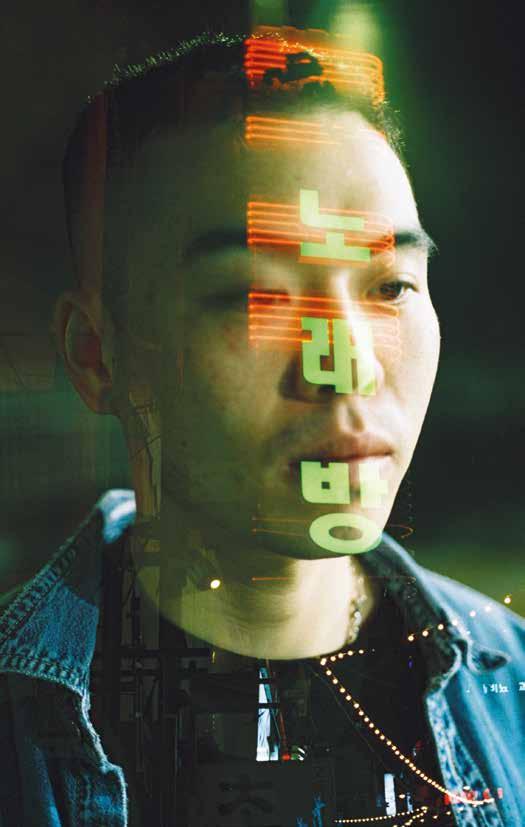
HOW DID YOU GET INTO CERAMICS?
I didn’t know about ceramics until the end of high-school. I decided to partake in a class assignment related to ceramics and that really got me hooked. I found the material and technique really exciting. From that point on I dedicated my creative energy towards that field—I even majored in ceramics.
WHAT INSPIRES YOU NOWADAYS?
Nowadays? My close friends. We can talk about our work and exchange our thoughts—they inspire me and I can inspire them back. When I started I was mostly inspired by ordinary things as well as traditional Korean patterns. I still find inspiration when I visit museums or look at books. I love to get inspiration by the old and mix it up with new things.
CAN YOU TELL ME WHAT MAKES YOUR WORK SPECIAL TO YOU?
I could show you some results, but maybe it’d be more interesting if I’d show you how to do pottery yourself. (He showed me how to throw clay and then we made some cups together. He fast dried them with a Bunsen burner.)
HOW DO YOU GO ABOUT WHEN STARTING A FRESH PIECE?
I work on the spur of the moment. I never really sketch my ideas out. It’s adding an additional step between the inspiration and the actual work—which to me doesn’t feel right. I prefer to translate my ideas straight into crafting. Another aspect that runs through my designs is storytelling. Each of my piece has its own story. Through all that usability remains important. In the end my pottery still is meant to serve a purpose.
Interview | Pictures: Omid FröhlichWHAT DO YOU THINK IS THE STRENGTH OF YOUR CHOSEN FIELD OF DESIGN?
I think as long my body supports me, I can make ceramics. These are the merits of ceramics. It’s not overly taxing and it is also not tied to a specific age. For example, the time you can be active in a company as a graphic designer is much shorter. Same goes for businessman, they will quit their work with 60. As ceramics is a craft, my craftsmanship will grow over time—increasing the value of my work the longer I keep doing it. Ceramics always played an important role in history. That’s why I take a certain pride in making ceramics—I’m standing in league with many important craftspeople and I myself am adding to this history.
WHAT IS YOUR BIGGEST CONCERN THESE DAYS?
‘QH’ is doing well these days. But I am thinking about how to make it better. “You have to row when water is coming in,” so they say. And I’m trying to figure out how to best row this boat.
IS THERE ANYTHING YOU WANT TO DO OR TRY AS A DESIGNER IN THE FUTURE?
My plan is to build a ‘QH’ factory. A huge multilayered workshop for different crafts. The ground floor will be dedicated to car workshops, the second floor will house a wood workshop, the third floor will accommodate for metal crafting, and on top of the building: A penthouse, where I will do ceramics.

Quite often I recognized scooters rushing by when meandering through the hustling traffic of Seoul. They belonged to delivery services that are tied to ghost kitchens. Ghost kitchens can be found all over Seoul. During Corona the brick-and-mortar restaurants had to take big losses. Many could only survive by offering food delivery—as in-house dining was prohibited for a long time.
This benefited delivery kitchens in two ways: They didn’t lose money because of ‘dead’ space in their restaurants—as they never housed guests to begin with. While at the same time the demand for food delivery exploded. The covid-19 pandemic accelerated the growth of the ghost kitchen industry by approximately five years within only three months. I personally loved their reusable plastic dishes which they picked up right from your doorstep after you finished.

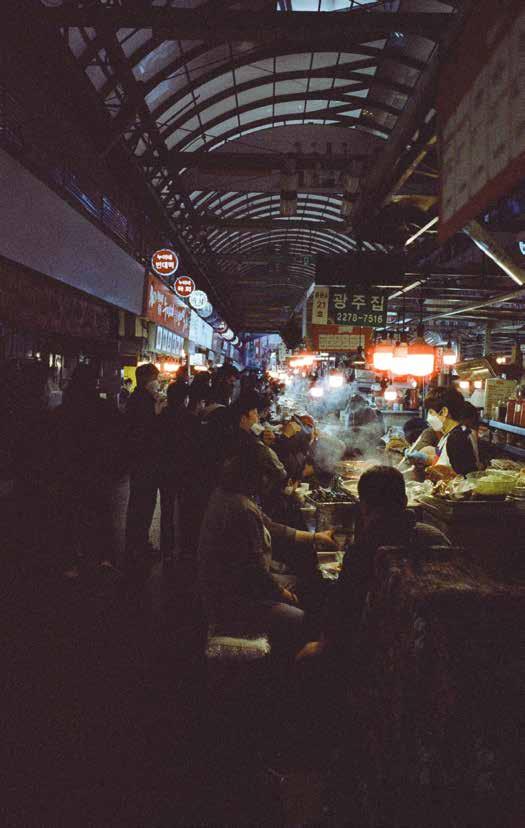




→Magazine Q.T


Layout for the summer issue, 2022.
←Berlin Typography
Layout for the November issue, 2018.




↑Portrait Series
Illustrations of historical figures.




↖Jeonju Intl. Film Festival
Poster for the Jeonju Intl. Film Festival.
↖↗Playing Dead
Album design for the artist ‘Haepa’ including poster and custom type design, 2022.
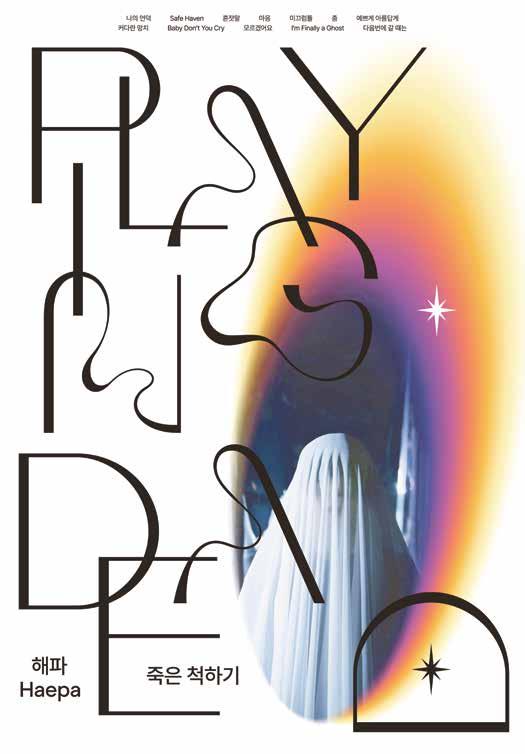

My alarm had been ringing since 7:00 am, but I usually woke up around at 8:00. It was hard to get out of my bed every morning because I went to sleep quite late due to me working overtime.
I needed to take a shower in the morning. It helped me to wake up.
07:00
After breakfast, I picked some trendy clothes which I haven’t worn in at least two weeks …
… then put on some make up …
I had a quick breakfast but only if there was some eatable food left in my fridge.
… and left my home around at 8:30.
I always stopped by a cafe on my way for buying a cup of coffee with a double espresso. It helped me to boost my energy and stay awake. 12 1
I had to be at the office at least 20mins before my real working time. Otherwise I got scolded by my boss.
9
10 11 WORK FOR FREE
When I arrived at my office the first thing I had to do was putting my finger onto the fingerprint machine. It was for signing in.
Then I checked that day’s schedule so I didn’t forget about anything important.
I had to sort my messy table. It was usually full of fabrics and some documents.
Sometimes, we had a morning meeting with all the designers and my boss.
Then I had to put the spoons and chopsticks and bring some water for the others. Because I was the youngest junior designer.
At lunch time, my boss tactically pushed me and other senior designers to have lunch together.
What it’s like being a junior fashion designer in South Korea

My name is Woojae. I’m 31 years old by the Korean age system and 29 years if you count via the international system. I’m a photographer and an illustrator. Therefore my main work is creating images. But it hasn’t always been like that, I used to repair motorcycles for some time. Back then I didn’t have any relation with the artistic scene, but I was already interested in visual media. That’s why I went to the PaTI university (Paju Typography Institute). There I focused on photography and art, which I continued working in ever since.
The people who inspired me recently are Markus and Omid, as well as the studio members who I’m working with. I’ve been working here for six years now. I feel that six years is neither a short nor a long time. But I also think that there is still more for me to learn and stuff that I can get better at. When I look at how my superiors are constantly working and improving it also motivates me to develop my skills. I also gained some new insight on production methods and professionalization from you two (Markus and Omid). So all of these different people inspire me, to do my work well.
Interview with Woojae LeeThere is nothing in particular. Honestly, I didn’t invest that much in studying the theory of photography or techniques during uni like reading some specialized books and applying that knowledge in my process. I don’t have this kind of expertise. I’m just working in quite a simple way. Like, trying to capture the image that came to my mind, just drawing the idea that I had, or taking pictures of my favorite motives. I’m not charging my work with any special meaning, but just deal with what I like and what I’m interested in creating.
My main obstacle is often a lack of knowledge or if the work is not for myself but for a client. In the latter case the problem often boils down to miscommunication and misunderstanding of what the client really wants. It’s kind of obvious but I would say, I’m only interested in what I feel interested in. Therefore I sometimes find it hard to get behind someone else’s ideas. This often results an me being concerned during the process. But so far it worked out—me and my clients were both satisfied with the outcomes I produced. Even though I wrap up my work quite satisfyingly, I’m often worried. For example I worry that I have nothing in common with my clients or our ideas don’t match up. Other times I can’t come up with any fresh ideas due to my lack of knowledge. That’s the thing: I have to google the fundamental things constantly in order to finish my work. When it comes to photography, there are some books about it, and they inspire me to get new ideas, by checking out the way the other photographers took their pictures. When it comes to drawing, I often get ideas by looking at art books. Luckily, it usually ends up the direction that I wanted to go, so it is fine. Anyway, reading a lot of books is my answer on how to overcome obstacles in my creative process.
Well, I do like drinking. I’m always up for drinking alcohol. I even started brewing my own beer. I’ve been doing that for six years by now. I also like to go to art museums, digging at record stores, or listening to music in a club is also great. And of course meeting friends. Overall nothing special. I usually spend my time with music, some visual works, and friends.
Because of my photography and art career I often draw satisfaction from my work. But next to the internal satisfaction there is also the external. As you know, people share their work through social media these days. So when people like my work on social media, it creates these short pleasure moments. I usually post my projects from work there. That creates the additional benefit that I can vibe-check if I’m going in the right direction. Trusting in my intuition is still the more important, but for additional feedback I find social media quite helpful. That and of course asking for the opinion of my friends.

My life before the Corona? I think it was pretty similar. The only difference is, that now I’m not able to go to a party after work. Otherwise it is pretty much the same. Because I work until late during the week I don’t really have that much personal life since I’ve moved to Korea due to work. I go to work, and than I come back home—that became my routine here. On weekend I try to see some friends of mine and try to have a good time with them. Or I read a book. I think that’s it. A very normal and unremarkable routine.
주중에는 보통 늦게까지 일하다 보니 제
개인생활이 거의 없어요. 출근하고 퇴근하는것, 한국에서 직장을
다니면서부터 그게 여기서의 제 평일 동안의 일상 전부가 되었어요.
그래도 주말에는 친구들을 만나려하고 또 그들과 좋은시간을 보내려
해요, 아니면 책을 읽거나. 하지만 그게 전부예요. 특별할것도 없는 아주
평범한 일상이죠.


Feminism refers to a theory or movement that should strengthen women’s rights and identity in society. It aims for gender-equality which is not a given in most (if not all) countries where a malecentered ideology is still predominant in defining the role of men and women. In a broader sense, feminism fights against societal and personal discrimination based on gender in its many forms and intersectional appearances.
However, feminism in South Korea has a very negative reputation. The movement is often perceived as a “female chauvinism,” the rejection of men in general or even hatred against men. This position is widespread and can be found especially amongst young Korean men. As a result, anti-feminist rhetoric and behavior is on the rise. Patriarchy is deeply engrained into Korean tradition and influences many everyday interactions. Because these minor and major discriminations seem to be the norm, many Koreans are reluctant towards change—if it’s normal, it must be so for a reason, and therefore be correct. Additionally patriarchy is anchored and legitimized through Confucianism— the predominant philosophy in South Korea for centuries. Confucianism aimed to order the whole universe and determine a place for every
Words: Youjin Kim & David Wiesner (Co-Writer) | Illustrations: Youjin Kim

Kunha Lee
106, 164, 180
graphicha.kr
@graphic.ha
Omid Fröhlich
8, 78, @omidfroh
Seung Hun Yoo
64, 140, 162
@oldshoess
Youjin Kim
146, 174
@uuuuz_z
Meesook Woo
112 moonanhan.com
@moonaanhaan
Dohwan Park ‘Pakdo’
22, 104, 168
@jayuldo_pakdo
Woojae Lee
118, 154, 160, 166
@wo0ojae
Yuri Park
172
@yur2isfragile
Slanted Publishers (UG) (haftungsbeschränkt)
Nördliche Uferstraße 4–6
76189 Karlsruhe
Germany
T +49 (0) 721 85148268 info@slanted.de slanted.de
@slanted_publishers
© Slanted Publishers, Karlsruhe, 2020
Nördliche Uferstraße 4–6, 76189 Karlsruhe, Germany
© Design by Omid Fröhlich, Youjin Kim, David Wiesner
All rights reserved.
ISBN: 978-0-948440-45-9
1st edition 2020
EDITORIAL & ARTISTIC LEAD
Omid Fröhlich
Youjin Kim
David Wiesner
PHOTOGRAPHY
Omid Fröhlich
LAYOUT & EDITING
David Wiesner
PUBLISHING DIRECTION
Lars Harmsen, Julia Kahl
PRODUCTION MANAGEMENT
Julia Kahl
PROOFREADING
Jürgen Fröhlich, Natascha Fröhlich, Anne Wiesner
FINAL DESIGN
Clara Weinreich
PRINTING
Balto Print
TYPEFACES
Fritzi Sans & Serif by David Wiesner
Happiness Sans by AG Typography Institute
Nanum Myeongjo by Fontrix & Sandoll
Futtenach Transitional by David Wiesner
Gimpel by David Wiesner
The publisher assumes no responsibility for the accuracy of all information. Publisher and editor assume that material that was made available for publishing, is free of third party rights. Reproduction and storage require the per mission of the publisher. Photos and texts are welcome, but there is no liability. Signed contributions do not necessarily represent the opinion of the publisher or the editor. The German National Library lists this publication in the German National Bibliography; detailed bibliographic data is available on the Internet at ‘dnb.d-nb.de.’
Slanted Publishers is an internationally active publishing and media house founded in 2014 by Lars Harmsen and Julia Kahl. They publish the award-winning print magazine Slanted, covering international developments in design and culture twice a year. Since its establishment in 2004, the daily Slanted blog highlights events and news from an international design scene and showcases inspiring portfolios from all over the world. In addition, Slanted Publishers initiates and creates publications, focusing on contemporary design and culture, working closely with editors and authors to produce outstanding publications with meaningful content and high quality. Slanted was born from great passion and has made a name for itself across the globe. Its design is vibrant and inspiring—its philosophy open-minded, tolerant, and curious.
Thank you to all the people that took time off in their busy schedules to give us interviews or shared their stories, works, and research. This book would not have been possible without you. Thanks to Youngji and Markus for making the trip to Seoul possible. Thanks to Prof. Iris Utikal for her feedback and support during the creation of the book as well as Kölner International School of Design (KISD) for giving us the opportunity to start this book as part of our curriculum.
A special thank you to Natascha and Jürgen Fröhlich, as well as Anne Wiesner for proofreading. Another special thanks to Dohwan Park, Johannes Mechler, Olga Funk, Henk Szanto, Katharina Reusteck, Jule Arden, Leonard Irtel von Brenndorff, and Bessie Norman for their feedback and input. Thanks to Julia Kahl and Slanted Publishers for taking good care of us during the publication process, as well as bringing these stories to a wider audience. Thanks as well to Tim Ahrens and Shoko Mugikura for their ‘Kern On’ plugin that was used to optimize the kerning of ‘Fritzi’ and ‘Futtenach Transitional.’
And thank You for taking time to read this book.

How could visiting Seoul be described in a way that allows someone else to feel like they are right there? What to say? What perspectives to choose? ‘What should I say—about Seoul’ takes the reader on a path less traveled: The work and daily-life of Korean designers; but not just as a spectator. Traveling invites the traveler to question one’s own perspective. The reader is invited to also learn about Korean designers’ views on Germany (our point of reference). The insights found through this process are inspiring as well as challenging.